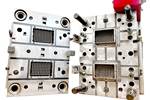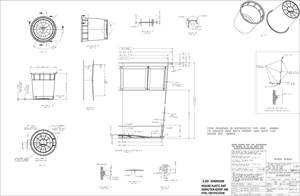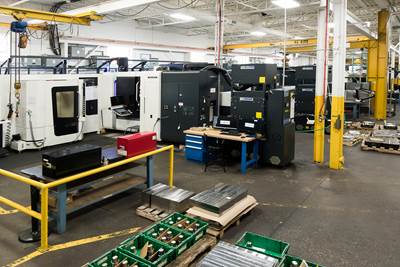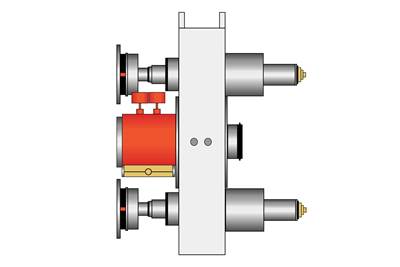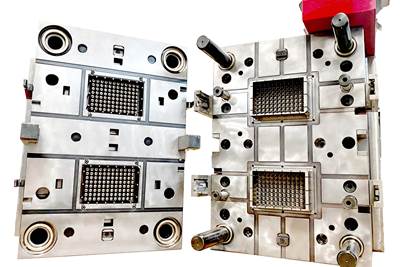
Molded Precision Components Inc. (MPC) is a full-service, vertically integrated moldmaker and injection molder serving customers in the automotive, medical device, packaging, industrial and off-highway/ground transportation segments. The company also has an aggressive seven-day reshoring program that customers in many markets use. Shown above is a tool MPC produced and used to mold a pair of sub-1 gram automotive connectors. Photo Credit: Molded Precision Components Inc.
What is now Molded Precision Components Inc. (MPC) was founded in 1980 as a prototyping and product development shop under the name Molded Plastic Consultants. Long-time friends and plastic industry colleagues David Yeaman, P.Eng., and Thomas Woegerer, P.Eng., bought the company in 2006 and immediately converted it to a full-service, vertically integrated moldmaking and molding operation that now employs 90 people and operates two facilities totaling 70,000 square feet/6,503 square meters. A 2017 name change was made to better reflect its current services.
MPC is equipped with the latest equipment and uses scientific molding principles and Industry 4.0 manufacturing processes, running second and third shifts lights out with automated molding, quality control (QC), packaging and regrinding. The company is so busy that all the straight injection, two-shot, and overmolding tools it produces are used in-house to support its molding programs for customers in the automotive, medical device, packaging, industrial and off-highway/ground transportation segments. The company holds IATF 16949:2016 and ISO 9001:2015 certifications.

MPC’s molding operation uses scientific molding techniques and Industry 4.0 technology to assure lights-out repeatability. A critical aspect of MPC’s process quality control (QC) system is using in-cavity pressure sensors in every tool the team builds. Photo Credit: Molded Precision Components Inc.
A focus on both reshoring tools and molding programs, and keeping new programs competitive in North America is an important aspect of what MPC does day to day.
Reshoring Tools & Molding Jobs
MPC has an innovative seven-day reshoring program that uses its vertical integration, including part and tool design, moldfilling analyses, tool build, automation, molding, finishing, packaging and shipping. It even has both CMM and 3D optical scanning metrology equipment to ensure its own part quality is to spec.
Once an offshore tool is delivered to MPC, it’s carefully inspected and scanned, then compared against previously made parts and CAD files. If any maintenance or repairs are needed to bring the tool into compliance with customer requirements, they’re made. If running the job will require automation, the necessary equipment is built and tested. Then a molding trial is conducted, and parts are scanned to verify again that they meet production intent. Finally, assuming all is well, commercial production commences.
“We started offering this program to help customers de-risk the process of reshoring jobs, since every service or discipline they need, we offer in-house, which not only helps them get up and running again quickly but also eliminates concerns about handoffs to lots of different companies,” explains David Yeaman, MPC president and co-owner. He adds that customers in many segments have used MPC’s reshoring services. One area where they’ve had considerable success is with caps/closures.

MPC has invested in both ultraprecise coordinate measurement machine (CMM) and 3D blue-light optical scanner (3D OPPM) technologies, which the company uses to verify its own molded part quality as well as to verify if parts molded on reshored tools meet customer requirements as part of its reshoring program. Photo Credit: Molded Precision Components Inc.
“This is the first time North America has had significant and prolonged supply chain issues in a long time, so everyone now recognizes how fragile their supply chains are—particularly given the rising cost of quality control and shipping—causing many to reconsider their strategic global sourcing initiatives and opting to secure their supply closer to home,” continues Thomas Woegerer, MPC engineering vice president and co-owner. “These problems aren’t going away soon, and in the meantime, customers as well as consumers are recognizing the cost and environmental impact of global sourcing and are getting more serious about reducing pollution.”
Keeping New Jobs Competitive in Canada
MPC was recently awarded a job to build tooling and produce electrical connectors for an automotive program. The two-shot parts (glass-reinforced polyamide 6/6 (PA6/6) overmolded with thermoplastic vulcanizate (TPV)) required a shot size of just 0.8 grams/0.03 ounces and would be produced in modest volumes of less than one million parts per year. In addition, to ensure parts could be produced cost-competitively in Canada, the team decided to run the job in a low-cavitation tool on a small press.
“Instead of building a more costly eight-cavity tool and running it for a thousand hours at a time on a big press, only to have to pull it out to run other jobs throughout the year, it made more sense to build a two-cavity tool and run it in a dedicated production cell on a 10-ton press where it could run day in and day out,” explains Yeaman. He adds that they wanted to use a hot runner system to reduce residence time and scrap and, since they were overmolding with a soft TPV, they needed a valve gate system to avoid the risk of stringing.
“This approach would reduce overhead and energy usage, lower tooling costs and give us better process control—particularly given the small shot size and low cavitation—but it also would reduce risks during tool changeovers and make it easy to train technicians on the job,” adds Woegerer. The only problem with this approach was that the press in question had a very limited daylight opening (DLO) of just 255 millimeters/10 inches.

A dedicated team of multidisciplinary engineers and technicians in MPC’s Advanced Engineering department have the experience and skills to take a project from napkin sketch to finished packaged product, helping ensure customer projects are consistently delivered on time, on budget and to print. Photo Credit: Molded Precision Components Inc.
“With such a limited opening between the platens, by the time we added the hot sprues and manifold halves, we’d have eaten up two-thirds of our opening stroke,” Yeaman continues. “Plus, valve gate stack heights are taller than other gating options owing to the need to package the mechanism that fires the needle. So, going into this program, we knew we’d need both hot runner and valve gate solutions that were miniaturized to run in that press.” Fortunately, MPC had used Heitec compact hot runner systems from distributor Technoject Machinery Corp. for several years. The space-saving products from Heitec Heisskanaltechnik GmbH were ideal for smaller parts on lower cavitation tools. However, Heitec also produces runners in the full range of sizes, plus a broad range of other mold components.
The ability to offer compact sizes for hot runner nozzles, manifolds and actuators has many advantages for moldmakers and molders, including the ability to use them in smaller molds with the same number of cavities, and lower running costs, footprint and energy needs due to the capacity to mount tools in smaller presses.

Heitec’s First Line hot runner nozzles are available in very short lengths, such as the one shown above. Despite their compact size, they are said to maintain a superior thermal profile due to the use of a metallically connected heater coil. Photo Credit: Heitec Heisskanaltechnik GmbH/Technoject Machinery Corp.
Smaller by Design
Technoject is North America’s exclusive Heitec distributor and also represents Feller Engineering GmbH, a supplier of temperature controls, which Heitec uses for its systems. Paul Boettger, Technoject founder and owner, grew up in Germany and received his undergraduate degree in engineering with a polymers specialization. He says he’s always been interested in injection molding and, before founding Technoject 20 years ago, represented both Heitec and Feller at another firm.
Asked how Heitec ended up specializing in compact mold components, Boettger explains that before starting Heitec, its founder, Hans Schreck, had previously molded small, precision parts in engineering resins. “At the time he founded the company in 1986, commercially available hot runner systems had difficulties processing technical resins in the sub-1-gram range, so a big focus when he started Heitec was to provide systems that were capable of processing these articles,” he adds. “Even today, in the small article, direct-gate application area using engineering resins, there are only a small number of hot runner suppliers interested or willing to provide systems for that segment’s needs.”
“It’s clear that without Technoject supplying us with compact systems from Heitec, we wouldn’t have been cost-competitive enough to get this program.”
He notes that the ability to offer compact sizes for hot runner nozzles, manifolds and actuators has many advantages for moldmakers and molders, including the ability to use in smaller molds with the same number of cavities, and lower running costs, footprint and energy needs due to the capacity to mount tools in smaller presses. The latter brings the added benefits of reducing material residence times and broadening processing windows—important factors when molding costly, often temperature-sensitive engineering thermoplastics.
Boettger notes that it’s often challenging to produce miniature hot runner components with superior temperature profiles capable of handling engineering resins. “Heitec has invested many years of research into optimizing the thermal profile, developing the design of miniature hot runner components and offering unique customizations of nozzles and manifolds to offer more flexible mold designs,” he adds, also noting the company has significant experience modifying or customizing hot runner designs to meet unique project needs. In fact, many modified systems end up being offered as standard components later on, helping keep Heitec a leader in technical developments.
Beyond compact sizing, Boettger explains that the Heitec hot runner/valve gate system has additional features that make it an ideal choice beyond compact sizing, including a choice of actuations, such as pneumatic, hydraulic and servomotor drives—the latter which allow complete control over valve-pin movements, such as speed, timing, position, two-stage speeds and force limits with cycle stop. Other useful features include permanent pin centering, a special hard coating on wear components and free-flow versions without melt dividing.
“In today’s competitive environment, customers are always pushing the envelope on productivity, so moldmakers and molders seek lower operating costs, faster cycle times, zero-waste materials—especially when using technically challenging and costly resins—more compact mold designs, and better, more repeatable product quality,” Boettger continues. “To achieve all this requires a highly engineered hot runner system with superior performance even when installation sizes are reduced to a minimum.”
Up and Running
MPC requested bids and specs on valve gate systems from several suppliers to find components to fit the connector mold. “Everyone came back with a die stack height that just wouldn’t work,” Woegerer recalls. “We needed a cavity stack height of 140 millimeters [5.5 inches] max to allow the tool to fit into and function in the 10-ton press. These 140 millimeters needed to include the hot sprue, valve gate mechanism, manifold and hot drops. Other suppliers came back with cavity stack heights of 25-30 millimeters [0.98-1.2 inches] above this critical value. Still, Technoject came in at 138 millimeters [5.43 inches], giving us an additional 2 millimeters [0.08 inches] of room on our side, which was a surprise.”

This is a rendering of a Heitec hot-half design showing its low stack-up requirements of 104.61 millimeters/4.118 inches. Photo Credit: Heitec Heisskanaltechnik GmbH/Technoject Machinery Corp.
“They had an innovative system with a pressure cylinder mounted under the tool to trigger a vertical motion that, in turn, was translated by a rack-and-pinion system into horizontal motion to activate the valve gate needle,” Yeaman continues. “The whole valve-actuation system was packaged in a very thin envelope of just 36 millimeters [1.4 inches].”
He adds that installation was relatively straightforward, “Other than jigging around the cylinder mounted under the mold, offsetting inlets coming in from the injection unit and being creative with waterlines, the whole project represented straightforward mold design.”
The mold has been running for half a year and has produced 150,000-200,000 parts as the program, which is scheduled to launch this summer, slowly ramps up. “We’ve been getting excellent data so far and everything looks really good,” Woegerer adds. “It’s clear that without Technoject supplying us with compact systems from Heitec, we wouldn’t have been cost-competitive enough to get this program.”
Related Content
What You Need to Know About Hot Runner Systems and How to Optimize Their Performance
How to make the most out of the hot runner design, function and performance.
Read MoreRevisiting Some Hot Runner Fundamentals
What exactly does a hot runner do? If you’ve been in the injection molding industry for any length of time, you might think the answer is obvious, but it is not.
Read MoreIt Starts With the Part: A Plastic Part Checklist Ensures Good Mold Design
All successful mold build projects start with examining the part to be molded to ensure it is moldable and will meet the customers' production objectives.
Read MoreHow to Analyze and Optimize Cutting Conditions to Reduce Cycle Time
Plastic injection mold design and manufacturing company puts NC program optimization software module to the test. The results were surprising.
Read MoreRead Next
Top Grade Molds Is All About Innovation and Collaboration
Top Grade Molds develops technology solutions with a heavy emphasis on R&D, recyclable material trends and collaboration.
Read MoreDesign Your Tools for Moldability... and Maintenance
In the initial design phase, when considering the structure and elements of the tool, are you designing them to be maintenance friendly? Canon Virginia has used this approach and preventive maintenance to make tool replacement a thing of the past. You can, too. Here’s how.
Read MoreHot Runner, Mold Component Partnerships Lead to Innovative Mold Designs
Formula Plastics takes on tooling via sister company Formula Tooling using dedicated partners, 3D modeling services and highly trained engineers to develop advanced mold designs.
Read More

.jpg;width=70;height=70;mode=crop)


